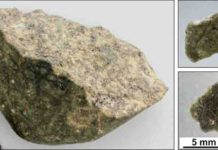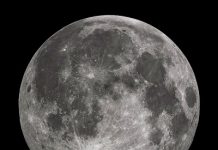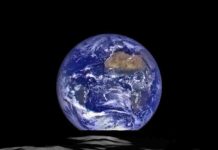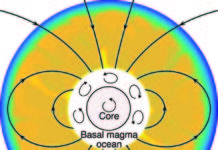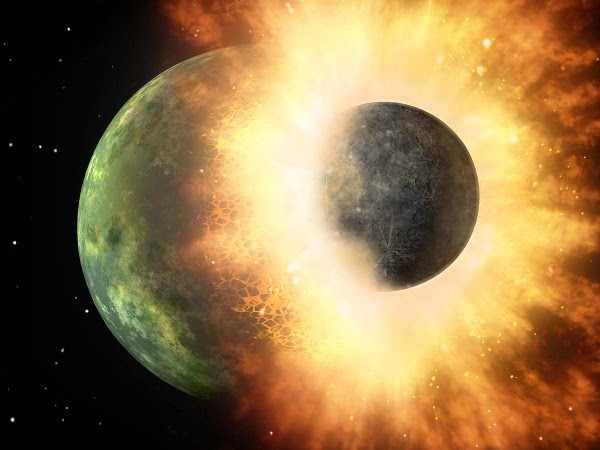
Planetary scientists have long believed that our moon formed following a collision between Earth and another planet, but studies of Earth and moon rocks suggest otherwise. A new analysis of the composition of moon rocks brought back by Apollo astronauts may help finally resolve the mystery.
Here’s the current thinking about how the moon formed. Early in its history, Earth was struck a glancing blow by a Mars-sized planet. That planet was destroyed by the impact, but much of its debris—and some of Earth’s—formed into a disk around Earth that eventually coalesced into the moon. Much evidence supports this scenario. The moon would have ended up hot, boiling off light elements and water, leaving the arid rocky moon we see today; the moon has a small core, consistent with being made from parts of the colliding planet and outer parts of Earth; the Earth-moon system rotates fast, consistent with a glancing blow.
But one bit of evidence just doesn’t fit: the composition of moon rocks. Researchers have found that rocks from different parts of the solar system (brought to Earth as meteorites) have subtle differences in their composition. Oxygen, for example, comes in different varieties, called isotopes. Oxygen-16 (O-16) is the most common type, followed by oxygen-17 (O-17)—which has one extra neutron in its nucleus—and oxygen-18, with two extra neutrons. Meteorites from different parts of the solar system have different proportions of these isotopes. So a rock from Mars would have a markedly different ratio of O-17 compared with O-16 than, say, a piece of an asteroid or a rock from Earth. These ratios are so reliable that researchers use them to identify where meteorites come from.
Here’s the puzzle: The giant impact hypothesis predicts that the moon should be made of about 70% to 90% material from the impactor, so its isotope ratios should be different from Earth’s. But ever since researchers got hold of Apollo moon rocks for analysis, they have failed to find any significant difference in isotope ratios on Earth and the moon. Studies of the isotopes of oxygen, titanium, calcium, silicon, and tungsten have all drawn a blank.
This discrepancy has troubled planetary scientists so much that in recent years they have put forward a number of alternative scenarios to explain the moon’s origins. One hypothesis suggests that there could have been much greater mixing between Earth and the debris disk as it coalesced after the impact, or if Earth was hit head-on by a similarly sized impactor, their remains could have mixed completely. Another possibility is that a fast-spinning Earth could have been hit by a much smaller impactor, which would have provided little material for the moon. Yet it has been hard to show how you could get from one of those events to the Earth-moon system we have today.
Researchers would prefer to stick with the original, plain vanilla impact scenario because it explains so many things so well. New results, published online today in Science, will give them some hope. Lunar rocks have a measurably higher ratio of O-17 over O-16 compared with those from Earth. The new study began because a team of researchers led by Daniel Herwartz of the University of Cologne in Germany had recently upgraded its mass spectrometer—a form of supersensitive atomic scale—and decided to test the device out on the Earth-moon isotope problem. “Our analysis is now an order of magnitude better than other laboratories,” says team member Andreas Pack of the University of Göttingen in Germany.
They started out analyzing moon rocks that arrived on Earth as meteorites but found that the weathering these rocks experienced on Earth was skewing the results. So they got hold of some rock samples from NASA that had been brought back by Apollo missions 11, 12, and 16. They extracted oxygen from all the samples and then passed it through the spectrometer to find out the proportions of each isotope. Their conclusion was that the lunar samples had an O-17 to O-16 ratio that was 12 parts per million higher than rocks derived from Earth’s mantle. This difference “supports the view that the Moon formed by a giant collision of the proto-Earth with [an impactor],” the team writes. “It is a relief that a [disparity in ratios] has been found, since the total absence of difference between Earth and moon would be hard to explain,” comments planetary scientist David Stevenson of the California Institute of Technology in Pasadena, in an e-mail.
The team acknowledges other possible explanations for the difference, including that Earth was bombarded by material with a lower oxygen isotope ratio at some time after the impact. “Now that a difference has been found, many will work to confirm or deny it and do battle over what it means,” Stevenson says.
The team says the results suggest that the moon is a roughly 50-50 mix of Earth and impactor material. Moreover, the high oxygen isotope ratio suggests that the impactor was principally made of a rare material called enstatite chondrite. The vast majority of meteorites that land on Earth are chondrites, but only about 2% of those are enstatite chondrites. “The possible significance of enstatite chondrites is interesting, but at present we are stuck with speculating about the bodies that went into making Earth, since they are no longer around,” Stevenson says.
Note : The above story is based on materials provided by Daniel Clery ” sciencemag “




